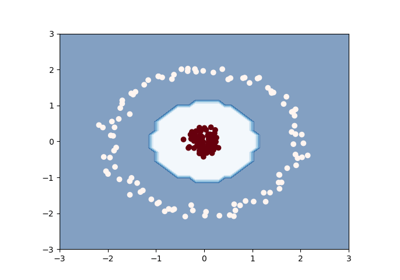gemclus.gemini.ChiSquareGEMINI¶
- class gemclus.gemini.ChiSquareGEMINI(ovo=False, epsilon=1e-12)[source]¶
Implements the one-vs-all and one-vs-one Chi Squared divergence GEMINI.
The one-vs-all version compares the chi square divergence between a cluster distribution and the data distribution.
\[\mathcal{I} = \mathbb{E}_{y \sim p(y)}[D_{\chi^2}(p(x|y)\|p(x))]\]The one-vs-one version compares the chi square divergence between two cluster distributions.
\[\mathcal{I} = \mathbb{E}_{y_a,y_b \sim p(y)}[D_{\chi^2}(p(x|y_a)\|p(x|y_b))]\]- Parameters:
- ovo: bool, default=False
Whether to use the one-vs-all objective (False) or the one-vs-one objective (True).
- epsilon: float, default=1e-12
The precision for clipping the prediction values in order to avoid numerical instabilities.
References
Sugiyama, M., Yamada, M., Kimura, M., & Hachiya, H. (2011). On information-maximization clustering: Tuning parameter selection and analytic solution. In Proceedings of the 28th International Conference on Machine Learning (ICML-11) (pp. 65-72).
- compute_affinity(X, y=None)¶
Unused for f-divergences.
- Returns:
- None
- evaluate(y_pred, affinity, return_grad=False)[source]¶
Compute the GEMINI objective given the predictions \(p(y|x)\) and an affinity matrix. The computation must return as well the gradients of the GEMINI w.r.t. the predictions. Depending on the context, the affinity matrix affinity can be either a kernel matrix or a distance matrix resulting from the compute_affinity method.
- Parameters:
- y_pred: ndarray of shape (n_samples, n_clusters)
The conditional distribution (prediction) of clustering assignment per sample.
- affinity: ndarray of shape (n_samples, n_samples)
The affinity matrix resulting from the compute_affinity method. The matrix must be symmetric.
- return_grad: bool, default=False
If True, the method should return the gradient of the GEMINI w.r.t. the predictions \(p(y|x)\).
- Returns:
- gemini: float
The gemini score of the model given the predictions and affinities.
- gradients: ndarray of shape (n_samples, n_clusters)
The derivative w.r.t. the predictions y_pred: \(\nabla_{p (y|x)} \mathcal{I}\)
Examples using gemclus.gemini.ChiSquareGEMINI¶

Clustering with the squared-loss mutual information